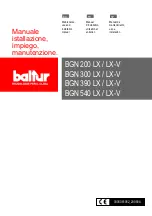
39
EXAMPLE 1: 0–2000 ft. (0--610 M) altitude
For 22,000 Btuh per burner application use Table
12
.
Heating value = 1000 Btuh/cu ft.
Specific gravity = 0.62
Therefore: Orifice No. 43*
Manifold pressure: 3.7--In. W.C. for high--heat
1.6--In. W.C. for low--heat
* Furnace is shipped with No. 43 orifices. In this example all
main burner orifices are the correct size and do
not need to be changed to obtain proper input rate.
3. Adjust manifold pressure to obtain low fire input rate. (See
Fig. 49.)
a. Turn gas valve ON/OFF switch to OFF.
b. Remove manifold pressure tap plug from gas valve.
c. Connect a water column manometer or similar device
to manifold pressure tap.
d. Turn gas valve ON/OFF switch to ON.
e. Move setup SW1—2 on furnace control to ON posi-
tion to lock furnace in low--heat operation. (See Table
52 and Fig. 26.)
f. Manually close blower door switch.
g. Jumper R and W/W1 thermostat connections on con-
trol to start furnace. (See Fig. 26.)
h. Remove regulator adjustment cap from low heat gas
valve pressure regulator (See Fig. 49.) and turn low--
heat adjusting screw (3/16 or smaller flat--tipped
screwdriver) counterclockwise (out) to decrease input
rate or clockwise (in) to increase input rate.
NOTE
: DO NOT set low--heat manifold pressure less than
1.4--In. W.C. or more than 1.7--In. W.C. for natural gas. If
manifold pressure is outside this range, change main burner
orifices.
i. Install low--heat regulator adjustment cap.
j. Move setup switch SW1--2 to off position after com-
pleting low--heat adjustment.
k. Leave manometer or similar device connected and
proceed to Step 4.
4. Adjust manifold pressure to obtain high fire input rate.
(See Fig. 49.)
a. Jumper R to W/W1 and W2 thermostat connections on
furnace control. This keeps furnace locked in high--
heat operation.
b. Remove regulator adjustment cap from high--heat gas
valve pressure regulator (See Fig. 49) and turn high
heat adjusting screw (3/16--in. or smaller flat--tipped
screwdriver) counterclockwise (out) to decrease input
rate or clockwise (in) to increase input rate.
NOTE
: DO NOT set high--heat manifold pressure less than
3.2--In. W.C. or more than 3.8 In. W.C. for natural gas. If
manifold pressure is outside this range, change main burner
orifices to obtain manifold pressure in this range.
c. When correct input is obtained, replace caps that con-
ceal gas valve regulator adjustment screws. Main
burner flame should be clear blue, almost transparent.
d. Remove jumpers R to W/W1 and R to W2.
5. Verify natural gas input rate by clocking meter.
NOTE
: Gas valve regulator adjustment caps must be in place for
proper input to be clocked.
a. Turn off all other gas appliances and pilots served by
the meter.
b. Move setup switch SW1--2 to ON position. This
keeps furnace locked in low--heat operation.
c. Jumper R to W/W1.
d. Run furnace for 3 minutes in low--heat operation.
e. Measure time (in sec) for gas meter to complete 1
revolution and note reading. The 2 or 5 cubic feet dial
provides a more accurate measurement of gas flow.
f. Refer to Table 11 for cubic ft. of gas per hr.
g. Multiply gas rate cu ft./hr by heating value (Btuh/cu
ft.) to obtain input. If clocked rate does not match re-
quired input from Step 1, increase manifold pressure to
increase input or decrease manifold pressure to de-
crease input. Repeat steps b through e until correct
low--heat input is achieved. Re--install low heat regu-
lator seal cap on gas valve.
h. Move setup switch SW1--2 to OFF position and jump-
er R to W/W1, and W2. This keeps furnace locked in
high--heat operation. Repeat items d through g for
high--heat operation.
6. Set Temperature Rise
NOTE
: Blower access door must be installed when taking
temperature rise reading. Leaving blower access door off will
result in incorrect temperature measurements.
FURNACE DAMAGE HAZARD
Failure to follow this caution may result in shorten furnace
life.
Set air temperature rise within limits specified on the rating
plate to prevent reduced life of furnace components.
Operation is within a few degrees of the mid--point of rise
range when setup switch SW1--4 is OFF.
CAUTION
!
UNIT DAMAGE HAZARD
Failure to follow this caution may result in overheating the
heat exchangers or condensing flue gases in heat exchanger
areas not designed for condensate.
Temperature rise must be within limits specified on unit
rating plate. Operation is within a few degrees of midpoint
of rise range when setup switch SW1--4 is OFF.
CAUTION
!
When setup switch SW1--4 is ON, operation will be near the high
end of the rise range for improved comfort.
Furnace must operate within ranges of temperature rise specified
on the furnace rating plate. Determine air temperature rise as
follows:
a. Place thermometers in return and supply ducts as near
furnace as possible. Be sure thermometers do not see
heat exchanger so that radiant heat does not affect
readings. This practice is particularly important with
straight--run ducts.
b. When thermometer readings stabilize, subtract return--
air temperature from supply--air temperature to determ-
ine air temperature rise.
NOTE
:
Temperature rise can be determined for low--heat
operation by placing setup switch SW1--2 on furnace control in
ON position. For high--heat operation, place setup switch SW1--2
in OFF position and jumper R--W2 on furnace control. DO NOT
forget to return setup switch to OFF position and remove R--W2
jumper upon completion of testing.
c. This furnace is capable of automatically providing
proper airflow to maintain the temperature rise within
314AA
V
Содержание 314A
Страница 3: ...3 A10269 Fig 1 Clearances to Combustibles 314AAV...
Страница 41: ...41 A13214 Fig 55 Wiring Diagram 314AAV...
















































